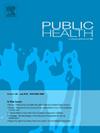卫生知识普及与按性别划分的未满足医疗需求之间的关系
IF 3.9
3区 医学
Q1 PUBLIC, ENVIRONMENTAL & OCCUPATIONAL HEALTH
引用次数: 0
摘要
目的了解影响未满足医疗需求(UMN)的因素对制定有效的干预措施至关重要。本研究旨在探讨健康素养(HL)与UMN的性别关系。研究设计:定量调查分析。方法:我们使用来自2021年韩国健康小组(KHP)的数据,共有10,073名参与者。感兴趣的变量是HL,使用HLS-EU-Q16进行测量,因变量是UMN,根据受访者在过去12个月内由于财务或非财务原因而未满足医疗需求的自我报告经历进行测量。首先调查了UMN的经历,然后调查了发生的原因。调整后采用多元logistic回归评估HL与UMN的相关性。结果男性有问题HL和不充分HL的发生率分别为12.7%和12.5%;女性分别为14.3%和13.2%。HL与UMN在男性和女性参与者中均显著相关,调整后的优势比分别为1.37和1.85;问题HL和不足HL分别为1.46和1.50。在30岁以下的男性和女性中,UMN的优势比与低HL相关。UMN优势比也与高学业成绩和低HL的非运动组相关。结论低HL与高UMN相关。这些发现强调了改善HL以减少UMN发生的重要性,值得在该领域进一步研究。本文章由计算机程序翻译,如有差异,请以英文原文为准。
The association between health literacy and unmet medical needs by gender
Objectives
Understanding the factors influencing unmet medical needs (UMN) is crucial for developing effective interventions. This study aims to investigate the association between health literacy (HL) and UMN by gender.
Study design
Quantitative survey analysis.
Methods
We used data from the 2021 Korea Health Panel (KHP) with 10,073 participants. Variable of interest was HL, measured using the HLS-EU-Q16, and the dependent variable was an UMN, measured based on respondents' self-reported experiences of unmet medical needs due to financial or non-financial reasons over the past 12 months. First, the UMN experience was investigated, and then the reason for the occurrence was investigate. Multiple logistic regression was used to assess the association between HL and UMN after adjusted.
Results
UMN rates with problematic and inadequate HL were 12.7 % and 12.5 %, respectively, for males; and 14.3 % and 13.2 %, respectively, for females. HL was significantly associated with UMN among both male and female participants, with adjusted odds ratios of 1.37 and 1.85, respectively; and 1.46 and 1.50, respectively, for problematic and inadequate HL. The odds ratio of UMN was associated with low HL in the groups under 30 years of age for both men and women. The UMN odds ratio was also associated with high academic achievement and the non-exercise group with low HL.
Conclusion
Low HL is associated with a higher likelihood of UMN. These findings emphasize the importance of improving HL to reduce the occurrence of UMN, warranting further research in this area.
求助全文
通过发布文献求助,成功后即可免费获取论文全文。
去求助
来源期刊

Public Health
医学-公共卫生、环境卫生与职业卫生
CiteScore
7.60
自引率
0.00%
发文量
280
审稿时长
37 days
期刊介绍:
Public Health is an international, multidisciplinary peer-reviewed journal. It publishes original papers, reviews and short reports on all aspects of the science, philosophy, and practice of public health.
 求助内容:
求助内容: 应助结果提醒方式:
应助结果提醒方式:


